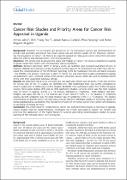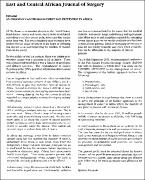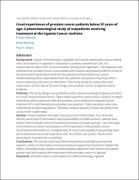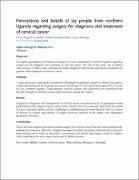| dc.description.abstract | Research into aetiologies and prevention of the commonest cancers and implementation of
primary and secondary prevention can reduce cancer risk and improve quality of life. Moreover, monitoring the prevalence of cancer risk factors in a specific population helps guide cancer prevention and early
detection efforts and national cancer control programming.
This article aims to provide the scope and findings of cancer risk studies conducted in Uganda
to guide researchers, health-care professionals, and policymakers.
Methods: Between November 2019 to January 2020, we searched peer-reviewed published articles in
Pubmed, EMBASE and Cochrane Library (Cochrane central register of controlled trials-CENTRAL). We followed the recommendation of the Preferred Reporting Items for Systematic Reviews and Meta-Analyses
– the PRISMA. The primary focus was to identify cancer risk and prevention studies conducted in Uganda
and published in peer-reviewed journals from January 2000 and January 2020. We used key Boolean search
terms with their associated database strings.
We identified 416 articles, screened 269 non-duplicate articles and obtained 77 full-text articles
for review. Out of the 77 studies, we identified one (1%) randomized trial, two (2.5%) retrospective
cohort studies and 14 (18%) case-control studies, 46 (60%) cross-sectional studies, five (6.4%) ecological
studies, three panel studies (4%) and six (8%) qualitative studies. Cervical cancer was the most studied
type of cancer in Uganda (23.4%, n = 18 studies), followed by lymphomas – both Hodgkin and NonHodgkin sub-types (20.7%), n = 16 studies) and breast cancer (15.6%, n = 12 studies). In lymphoma
studies, Burkitt lymphoma was the most studied type of lymphoma (76%, n = 13 studies). The studies
concentrated on specific cancer risk awareness, risk perceptions, attitudes, uptake of screening, uptake of
human papillomavirus vaccination, the prevalence of some of the known cancer risk factors and obstacles
to accessing screening services.
The unmet need for comprehensive cancer risk and prevention studies is enormous in Uganda.
Future studies need to comprehensively investigate the known and putative cancer risk factors and
prioritize the application of the higher-hierarchy evidence-generating epidemiological studies to guide
planning of the national cancer control program. | en_US |






